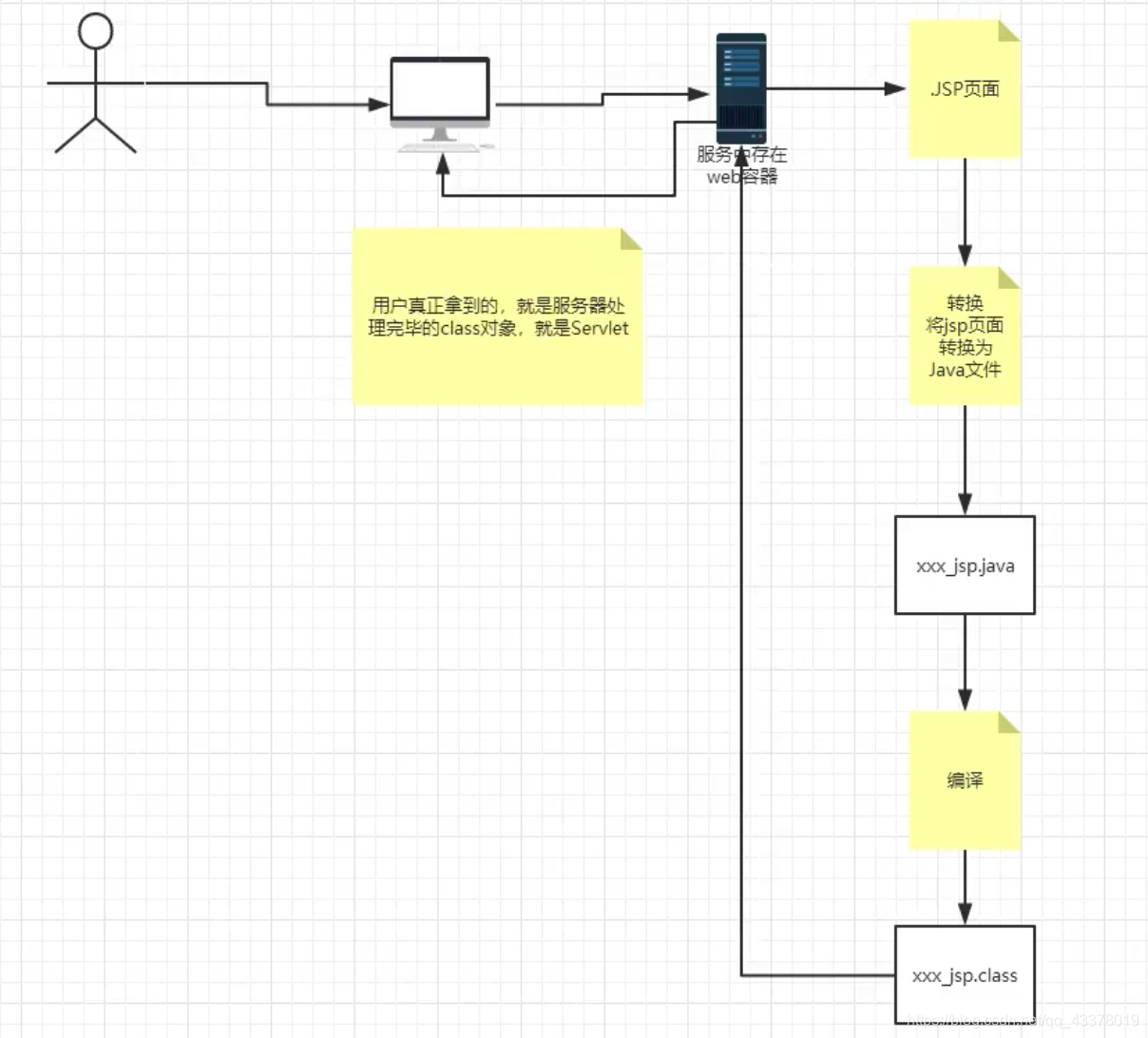1. JSP的定义
Java Server Pages: Java服务器端页面也和Servlet一样,用于动态Web技术。
最大的特点: 写JSP就像是写html
区别:html只给用户提供静态数据,但JSP页面中可以嵌入Java代码,为用户提供动态数据。
2. JSP原理
JSP怎么执行?
浏览器向服务器发送请求,不管访问什么资源,其实都是在访问serlet。而JSP最终也会被转换成一个Java类,因为他继承的HttpJspBase最终继承于HttpServlet。(观察index_jsp.java)
因此它本质上是一个servlet。
//初始化
public void _jspInit() {}
//销毁
public void _jspDestroy() {}
//JSPService
public void _jspService(final javax.servlet.http.HttpServletRequest request, final javax.servlet.http.HttpServletResponse response){}1. 判断请求
2. 内置了一些对象
final javax.servlet.jsp.PageContext pageContext; //页面上下文
final javax.servlet.ServletContext application; //appilicationContext
final javax.servlet.ServletConfig config; //config
javax.servlet.jsp.JspWriter out = null; //out
final java.lang.Object page = this; //page:当前
javax.servlet.jsp.JspWriter _jspx_out = null; //out
HttpServletRequest request
HttpServletResponse response3. 输出页面前增加的代码
//设置响应的页面类型
response.setContentType("text/html; charset=UTF-8");
pageContext = _jspxFactory.getPageContext(this, request, response, null, false, 8192, true);
jspx_page_context = pageContext;
application = pageContext.getServletContext();
config = pageContext.getServletConfig();
out = pageContext.getOut();
_jspx_out = out;4. 以上的这些对象可以在JSP页面中直接使用。

注:在jsp页面中,只要是java代码就会原封不动输出,html会转换成类似out.write("<html>\r\n")格式,输出到前端。
3. JSP语法
支持所有Java语法,也有一些自己扩充的语法。
JSP表达式
<%--JSP表达式
用来把程序的输出,输出到客户端
--%>
<%--JSP表达式
<%= 变量或表达式>
--%>
<%= new java.util.Date()%>
JSP脚本片段
<%--JSP脚本片段--%>
<%
int sum = 0;
for (int i = 2;i<30;i++){
sum+=i;
}
out.println("<h1>sum="+sum+"</h1>");
%>JSP脚本片段的再实现
<%--JSP脚本片段再实现--%>
<%
int x = 0;
out.println(x);
%>
<%
out.println(x);
%>
JSP中嵌入html元素
<%--JSP中嵌入html元素--%>
<%
for (int i = 0;i<5;i++){
sum+=i;
%>
<h1>hello</h1>
<%
}//输出五个hello
%>JSP声明
<% %>作用域在index_jsp.java文件下的public void _jspService里,在里面转译。而<%! %>作用域更高一级,称为jsp声明。
注<%-- --%>为注释符号,jsp的注释不会在客户端显示,但是html的<!-- -->会在客户端显示。安全性稍高。
4. JSP指令
<%@ page errorPage="Error/500.jsp" %>
<%@ page import="java.util.*" %>
<%@ page contentType="text/html;charset=UTF-8" language="java" %>//1.会将两个页面取出来合二为一,放在.java文件里。如果include的两个文件都有int i,会报500错误。
<%@include file="common/header.jsp" %>
//或者
//2.拼接页面,本质上是两个页面
<jsp:include page="/common/header.jsp"></jsp:include>5. 9个内置对象
- PageContext 存东西
- Request 存东西
- Response
- Session 存东西
- Application (ServletContext) 存东西
- config (ServletConfig)
- out
- page 不用了解
- exception
<%@ page isELIgnored="false" %>
<%@ page contentType="text/html;charset=UTF-8" language="java" %>
<html>
<head>
<title>Title</title>
</head>
<body>
<%--内置对象--%>
<%
pageContext.setAttribute("name1","公孙离1");//保存的数据在一个页面中有效
request.setAttribute("name2","公孙离2");//保存的数据在一次请求中有效,请求转发会携带这个数据
session.setAttribute("name3","公孙离3");//保存的数据只在一次会话中有效,从打开浏览器到关闭浏览器
application.setAttribute("name4","公孙离4");//保存的数据在服务器中有效,打开服务器到关闭服务器
%>
<%--脚本片段中的代码,会被原封不动生到.JSP.java
要求:这里代码必须保证java语法的正确性
--%>
<%
//pageContext.getAttribute();或通过寻找的方式取出
String name1 = (String) pageContext.findAttribute("name1");
String name2 = (String) pageContext.findAttribute("name2");
String name3 = (String) pageContext.findAttribute("name3");
String name4 = (String) pageContext.findAttribute("name4");
String name5 = (String) pageContext.findAttribute("name5");
System.out.println(name1);
%>
<%--使用el表达式输出 ${} --%>
<h1>取出的值为:</h1>
<h3>${name1}</h3>
<h3>${name2}</h3>
<h3>${name3}</h3>
<h3>${name4}</h3>
<h3>${name5}</h3>注:EL表达式不起作用的话,加入<%@page isELIgnored="false" %>
参考https://blog.csdn.net/qq_27825395/article/details/84841406
pageContext.setAttribute("name","hello",pageContext.SESSION_SCOPE);
//等价于
session.setAttribute("name","hello");注意事项:页面跳转的前后端的两种方式

应用场景:
- request:客户端向服务器发送请求,产生的数据,用户看完没用了,比如:新闻,用户看完没用的。
- session:客户端向服务器发送请求,产生的数据,用户用完一会儿还有用,比如:购物车;
- application:客户端向服务器请求,产生的数据,一个用户用完了,其他用户还能使用。比如记录。
6.JSP标签+JSTL标签+EL表达式
首先要在pom.xml里配置:
<!--JSTL表达式的依赖 -->
<!-- https://mvnrepository.com/artifact/javax.servlet.jsp.jstl/jstl-api -->
<dependency>
<groupId>javax.servlet.jsp.jstl</groupId>
<artifactId>jstl-api</artifactId>
<version>1.2</version>
</dependency>
<!--standard标签库 -->
<!-- https://mvnrepository.com/artifact/taglibs/standard -->
<dependency>
<groupId>taglibs</groupId>
<artifactId>standard</artifactId>
<version>1.1.2</version>
</dependency>6.1 EL表达式作用:${ }
- 获取数据
- 执行运算
- 获取web开发的常用对象
调取java方法
6.2 JSP标签
三种常用标签:
<jsp:include page="index.jsp"></jsp:include>
<%--跳转页面并携带信息--%>
<jsp:forward page="/jsptag2.jsp">
<jsp:param name="name" value="公孙离"/>
<jsp:param name="age" value="15"/>
</jsp:forward>在另一个页面(jsp文件)中取信息:
<%--取出参数:也可以用EL表达式--%>
名字:<%=request.getParameter("name")%>
年龄:<%=request.getParameter("age")%>6.3 JSTL(JSP标准标签库)
核心标签是最常用的 JSTL标签。引用核心标签库的语法如下:
<%@ taglib prefix="c" uri="http://java.sun.com/jsp/jstl/core" %>
JSTL标签库的使用就是为了弥补html标签的不足,它自定义了许多的标签,可以供我们使用。标签的功能和java代码一样。

JSTL标签库使用步骤:
- 引入对应的taglib
- 使用其中的方法
- ps:在tomcat(lib文件夹下)可能也需要手动引入jstl包,否则会报错:jstl解析错误。
<c:if>
<h4>if测试</h4>
<hr>
<form action="coreif.jsp" method="get">
<%--用EL表达式获取web开发常用的对象
${param.参数名}}
--%>
<input type="text" name="username" value="${param.username}">
<input type="submit" value="登陆">
</form>
<%--判断如果提交的用户是管理员,则登陆成功--%>
<%--
if(request.getParameter("username").equals("admin")){
out.println("登陆成功");
--%>
<%--用jstl标签库来写--%>
<c:if test="${param.username=='admin'}" var="isAdmin">
<c:out value="admin welcomes you!"></c:out>
</c:if>
<c:out value="${isAdmin}"></c:out><c:choose>

<c:foreach>
<%
ArrayList<String> people = new ArrayList<>();
people.add(0,"张三");
people.add(0,"李四");
people.add(0,"王五");
people.add(0,"赵六");
request.setAttribute("list",people);
%>
<%--
var: 每一次遍历出来的变量
items: 要遍历的对象
begin: 哪里开始
end: 哪里结束
step: 步长
--%>
<c:forEach var="people" items="${list}">
<c:out value="${people}"/>
</c:forEach>
<hr>
<c:forEach var="people" items="${list}" begin="1" end="3" step="2">
<c:out value="${people}"/>
</c:forEach>
7.JavaBean
是一个实体类
JavaBean有特定写法:
- 必须要有一个无参构造
- 属性必须私有化
- 必须有对应的get/set方法
一般用来和数据库的字段做映射ORM
ORM:对象关系映射
- 表--->类
- 字段--->属性
- 行记录--->对象


